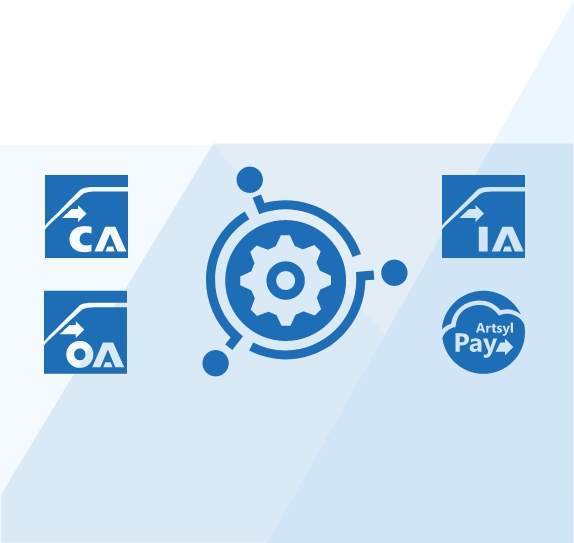Businesses generate data at an astonishing rate. From customer emails and financial records to product specifications and marketing materials, information flows in constantly. But with great data comes great responsibility — the responsibility to organize, secure, and utilize it effectively.
This is where data classification and classification software steps in as your data management knight in shining armor. Let’s take a peek into the world of data classification, explaining its process, software functionalities, benefits, and how it can empower your business to manage its information effectively.
Keep Reading to Learn:

Ensure your AP documents are accurately processed with InvoiceAction’s automated classification, data extraction, and validation.
Say goodbye to manual errors and streamline your AP processes.
What is Data Classification and Why is it Important?
Data classification is the process of organizing information within your organization based on its sensitivity and importance. It’s like sorting your belongings – you wouldn’t store precious jewelry in the same box as old newspapers, right? Data classification works similarly, establishing categories to ensure information is handled appropriately. Here’s why document data classification is crucial.
Can Data Classification Enhance Security?
By classifying data as confidential, public, or internal, you can implement specific security measures for each category. This protects sensitive information like customer records or financial data from unauthorized access.
Cybercriminals often target sensitive data. Classification helps you identify and prioritize the protection of this valuable information, minimizing the risk of breaches and data loss.
Data Classification and Regulatory Compliance
Many regulations, like GDPR or HIPAA, mandate how certain types of data are handled. Data classification helps you identify and manage this data effectively, ensuring compliance and avoiding hefty fines.
Data Classification and Improved Data Governance
Classification creates a clear understanding of what data you have, where it’s located, and who has access to it. This fosters better data governance, allowing for more efficient data management and retrieval.
Classification of Data and Streamlined Decision-Making
Knowing the classification of data allows for faster and more informed decision-making. Employees can easily locate relevant information and understand its appropriate use.
In essence, data classification is the foundation for effective data management. It ensures your organization understands its information assets, protects sensitive data, and leverages its full potential while adhering to regulations and minimizing security risks.
Streamline order processing and maintain precise data classification using OrderAction’s intelligent automation. Keep your order data accurate and accessible, enhancing overall efficiency.
Book a demo now
What Are the Types of Data Classification?
Data classification is an essential process for organizations to manage, protect, and optimize the use of their data. It involves categorizing data based on its sensitivity, value, and criticality to the organization. Here are some common types of data classification:
Public Data
This is information that is intended for public dissemination. It poses no risk to the organization if disclosed. Examples include press releases, marketing materials, publicly available financial reports, and website content. Minimal security is needed, but integrity must be maintained.
Internal Data
Information that is not meant for public access but is not highly sensitive. It is used internally within the organization, including internal communications, internal memos, employee handbooks, and internal process documents. Basic access controls ensure only employees have access.
Confidential Data
Sensitive information that could harm the organization if disclosed to unauthorized individuals. This data requires stricter access controls. Such data includes business plans, internal financial records, non-public contracts, and customer lists. Encryption, access controls, and regular audits to ensure compliance with security policies.
READ MORE: The AI Algorithms that Drive Invoice Data Extraction
Restricted Data
Highly sensitive information requires the highest level of security due to its critical nature. Unauthorized access or disclosure could result in significant damage. Trade secrets, proprietary formulas, confidential customer information, and classified government information require strong encryption, multi-factor authentication, strict access controls, and continuous monitoring.
Personal Data
Any information related to an identified or identifiable natural person must be handled in compliance with data protection regulations such as GDPR or CCPA. Names, addresses, social security numbers, email addresses, and medical records require data anonymization, encryption, access controls, and compliance with privacy laws.
Sensitive Personal Data
A subset of personal data that requires more protection due to its sensitive nature. It often includes information that can directly affect an individual’s privacy or security. Health information, biometric data, racial or ethnic origin, and political opinions must be protected with enhanced encryption, restricted access, and strict compliance with relevant privacy laws and regulations.
Regulated Data
Information that is subject to specific regulatory requirements. This classification ensures that data handling practices comply with applicable laws and standards. Such data includes financial data under SOX, health information under HIPAA, and credit card information under PCI-DSS.
Adherence to regulatory standards, regular audits, encryption, and access controls are essential.
Unstructured Data
This data does not have a pre-defined format or organization. It can be more challenging to classify and secure. Such data includes emails, social media posts, multimedia files, and documents. Data discovery tools, content management systems, and implementing security measures are based on the content’s sensitivity.
Structured Data
Data is organized in a fixed format, typically within databases. It is easier to classify and secure.
Examples include databases, spreadsheets, and CRM data. Database security measures, access controls, and encryption are required.
Intellectual Property
This information is related to the creations of the mind, such as inventions, literary and artistic works, designs, symbols, names, and images as well as patents, trademarks, copyrights, and proprietary research. Security measures include legal protections, encryption, access controls, and monitoring for unauthorized use or distribution.
Implementing a robust data classification strategy helps organizations protect their data assets, ensure compliance with regulations, and optimize data management practices.
Best Practices in the Implementation of Data Classification Levels
To effectively implement data classification levels within an organization, follow these steps:
- Identify Data Assets: Inventory all data assets within the organization, categorizing them by type and sensitivity.
- Define Classification Criteria: Establish clear criteria for each classification level based on the data’s sensitivity, value, and regulatory requirements.
- Classify Data: Assign each data asset to an appropriate classification level according to the defined criteria.
- Implement Security Controls: Apply security measures corresponding to each classification level to ensure proper protection.
- Educate Employees: Train employees on data classification policies and procedures to ensure they understand how to handle data appropriately.
- Monitor and Review: Regularly review and update data classifications and security controls to adapt to changing threats and business needs.
Implementing a robust data classification framework helps organizations protect their data assets, ensure compliance with regulations, and optimize data management practices.
Leverage docAlpha’s advanced OCR and IDR technologies to automate the classification of all your documents. Save time, reduce errors, and ensure consistent data handling across your organization.
Book a demo now
Real-Life Use Cases of Data Classification Done Right
Here are some real-life use cases of data classification done right, showcasing the benefits across different industries.
Healthcare Data Classification
A hospital struggles to manage a massive amount of patient data, including electronic health records, financial information, and medical images. Data classification software identifies and categorizes patient data based on its sensitivity (e.g., highly confidential medical history vs. appointment scheduling information). This allows the hospital to implement stricter access controls for sensitive data and ensure compliance with HIPAA regulations.
Finance Data Classification Software Use
A bank processes a vast amount of customer information, including account details, financial transactions, and loan applications. Data classification software classifies customer data based on its confidentiality (e.g., Social Security numbers vs. contact information). This helps the bank prioritize security measures for sensitive data and ensures compliance with financial regulations. Additionally, it allows for faster processing of loan applications by identifying the relevant information quickly.
Retail Data Classification Challenges
A retail chain collects customer data through online purchases, loyalty programs, and in-store transactions. Data classification software categorizes customer data based on its purpose (e.g., purchase history for personalized marketing vs. contact information for customer service). This allows the retailer to target marketing campaigns effectively while adhering to data privacy regulations regarding personal information.
LEARN MORE: Discover How AP Automation Supports Lean
Legal Data Classification Software Use
A law firm typically deals with a high volume of sensitive documents, including client contracts, litigation files, and confidential communications. Data classification software identifies and classifies legal documents based on their sensitivity (e.g., highly confidential client information vs. internal administrative documents). This helps the law firm restrict access to sensitive data, prevent accidental leaks, and ensure client confidentiality.
Education Data Classification
A university manages student records, research data, and administrative documents. Data classification software helps categorize information based on its accessibility (e.g., public course materials vs. private student records). This ensures student privacy is protected for sensitive information while allowing for easy access to public materials.
These are just a few examples, and the benefits of data classification can be applied across various industries. By implementing data classification effectively, organizations can achieve better data governance, improve security, ensure compliance, and ultimately leverage their information assets for better decision-making and business growth.
Integrate InvoiceAction with your ERP, CRM, and accounting systems to ensure seamless data flow and accurate document classification. Enhance your financial operations with precise data management.
Book a demo now
Data Classification Software: How Does It Help?
Data classification software is a crucial tool for organizations to manage, protect, and optimize their data. These tools help automate the process of identifying, classifying, and securing data based on predefined criteria. Here are some key features, benefits, and popular options for data classification software.
Key Features of Data Classification Software
- Automated classification: Uses algorithms and machine learning to automatically classify data based on content, context, and metadata.
- Policy enforcement: Applies classification labels according to predefined policies and ensures compliance with internal and external regulations.
- Data discovery: Identifies and catalogs data across various storage locations, including databases, cloud storage, and file systems.
- Real-time monitoring: Continuously monitors data to detect any changes or movements and ensure that classification policies are consistently applied.
- Integration: Integrates with existing security infrastructure such as Data Loss Prevention (DLP), encryption, and access control systems.
- Reporting and analytics: Provides detailed reports and analytics to track data classification, policy enforcement, and potential risks.
Benefits of Data Classification Software
Data classification software ensures sensitive data is adequately protected by applying appropriate security measures based on classification. As a result, classification tools help organizations comply with data protection regulations such as GDPR, HIPAA, and CCPA by accurately classifying and protecting regulated data.
DISCOVER MORE: Document Processing Software for ERP
In addition, data classification software facilitates efficient data management by categorizing data according to its importance and sensitivity. It identifies and mitigates risks associated with data breaches, unauthorized access, and data leaks.
Finally, data classification software automates the data classification process, reducing the manual effort required and increasing accuracy.
Intelligent Document Data Classification Software: How It Helps
Artsyl docAlpha is an intelligent data capture and document processing solution that helps organizations automate the classification and extraction of data from various types of documents. Here’s how Artsyl docAlpha supports data classification.
Key Features of Artsyl docAlpha for Data Classification
Intelligent Data Capture
docAlpha utilizes advanced optical character recognition (OCR) and machine learning technologies to accurately capture and digitize data from physical and digital documents.
Automated Document Classification
docAlpha Automatically classifies documents based on predefined rules, patterns, and content. This can include invoices, purchase orders, receipts, and other document types.
Users can also define custom workflows and classification rules tailored to specific business needs. This flexibility ensures that documents are categorized correctly according to the organization’s requirements.
Content-Based Classification
Intelligent document processing platform analyzes the content within documents to classify them appropriately. This includes understanding the context and extracting key data points such as dates, amounts, and customer information.
docAlpha Integration with Business Systems
Seamlessly integrates with enterprise resource planning (ERP), customer relationship management (CRM), and document management systems (DMS). This ensures that classified data is accurately transferred to and utilized within these systems.
READ NEXT: Automating Data Entry using docAlpha
Benefits of Using Artsyl docAlpha for Data Classification
First and foremost, docAlpha reduces the risk of errors associated with manual data entry and classification. The automated processes ensure consistent and accurate data capture and classification. Documents are classified according to regulatory and compliance requirements. This is particularly important for industries with strict data handling and reporting standards.
In addition, docAlpha speeds up the document processing workflow, allowing organizations to handle large volumes of documents quickly and efficiently. This leads to significant time and cost savings.
docAlpha integrates with existing business systems to streamline operations and improve data accessibility. Classified data is readily available for further processing, analysis, and decision-making.
By leveraging Artsyl docAlpha for data classification, organizations can automate and optimize their document processing workflows, resulting in improved accuracy, efficiency, and compliance.
Key Features of Artsyl docAlpha for Document Data Classification
Artsyl docAlpha supports document data classification through a combination of advanced technologies and customizable workflows designed to automate and enhance the accuracy of document processing. Here’s a detailed explanation of how Artsyl docAlpha supports this process:
Advanced Optical Character Recognition (OCR)
docAlpha utilizes advanced OCR technology to accurately extract text and data from both structured and unstructured documents. This ensures that all relevant information is captured digitally, regardless of the document’s format.
Intelligent Document Recognition (IDR)
IDR capabilities allow docAlpha to identify and categorize documents based on their content and layout. The system uses predefined templates and machine learning to recognize different document types, such as invoices, purchase orders, and receipts.
Content-Based Classification
The software analyzes the content within documents to determine their classification. This includes understanding contextual information and extracting key data points such as dates, amounts, names, and addresses.
Customizable Classification Rules
Organizations can define custom classification rules within docAlpha to meet their specific needs. These rules can be based on keywords, document structure, metadata, or other criteria relevant to the business.
Automated Workflow Processing
docAlpha supports the creation of automated workflows that guide documents through the classification process. These workflows ensure that documents are processed consistently and efficiently, reducing manual intervention.
Machine Learning and AI Integration
The platform leverages machine learning and artificial intelligence to improve classification accuracy over time. As the system processes more documents, it learns from corrections and adapts its algorithms to enhance future performance.
The software integrates seamlessly with existing business systems such as ERP, CRM, and DMS. This ensures that classified data is transferred accurately to other applications, facilitating smooth data flow across the organization.
By leveraging Artsyl docAlpha for document data classification, organizations can automate and enhance their document processing workflows, resulting in improved accuracy, efficiency, and compliance.
Utilize OrderAction to automate cross-checks and ensure your order data is always compliant with business rules and regulations. Keep your data classification processes robust and reliable.
Book a demo now
Understanding Data Classification: Key Terms to Know
What Is Data Sensitivity in Data Classification?
Data sensitivity refers to the level of importance assigned to data, based on its potential impact if accessed, disclosed, or modified without authorization. Sensitive data typically includes personal information, financial records, intellectual property, and other confidential information. The sensitivity level determines the necessary security measures and access controls to protect the data. Properly classifying data sensitivity is crucial for compliance with regulations and protecting organizational assets.
Why Is Access Control Important?
Access control is the process of managing who has permission to view or use resources within a computing environment. It involves implementing policies and technologies to restrict access to sensitive data based on user roles, responsibilities, and the principle of least privilege. Effective access control mechanisms ensure that only authorized personnel can access classified information, reducing the risk of data breaches. Methods of access control include authentication, authorization, and accounting.
What is Data Lifecycle Management?
Data Lifecycle Management is the policy-based approach to managing the flow of data throughout its lifecycle—from creation and initial storage to when it becomes obsolete and is deleted. DLM involves classifying data according to its value and sensitivity, ensuring it is stored securely, and that appropriate retention and disposal policies are followed.
Proper DLM practices help organizations maintain data integrity, comply with regulations, and optimize storage costs. It also ensures that data is available for use when needed while being protected from unauthorized access and loss.
What is the Role of Data Encryption?
Data encryption is the process of converting plaintext data into a coded form, called ciphertext, to prevent unauthorized access. Encryption uses algorithms and keys to ensure that only authorized parties can decrypt and access the original data.
Encryption is a critical component of data protection strategies, especially for sensitive and classified information. Encryption can be applied to data at rest (stored data) and data in transit (data being transmitted over networks).
What Is Metadata?
Metadata is data that provides information about other data, essentially serving as data about data. It includes details such as the data’s origin, author, date of creation, modification history, and access permissions. Metadata helps in organizing, finding, and managing data more efficiently, making it easier to enforce classification and security policies. In data classification, metadata plays a crucial role in identifying and categorizing data based on its attributes and context.
Understanding these key terms is essential for implementing effective data classification strategies and ensuring robust data management and protection within an organization.
Final Thoughts: Unleashing the Power of Your Data
Imagine a world where finding critical documents is a breeze and data security concerns are a thing of the past. With the right data classification software, that world is within reach.
Data classification software isn’t just about organization, it’s about unlocking the true potential of your information. By understanding your data landscape, you can ensure compliance with regulations, optimize security protocols, and facilitate efficient retrieval and analysis.
Take the first step towards data mastery – explore the solutions available and let your data work for you!
Use docAlpha’s powerful data classification capabilities to transform unstructured data into actionable insights. Improve decision-making and operational efficiency with organized and accessible data.
Book a demo now





 EDI: Enhancing Order Management with Automation
EDI: Enhancing Order Management with Automation Electronic Data Interchange (EDI) in AP and Invoice Processing
Electronic Data Interchange (EDI) in AP and Invoice Processing What is Electronic Data Interchange (EDI)
What is Electronic Data Interchange (EDI) Data Extraction Tools for Business Optimization
Data Extraction Tools for Business Optimization The Power of Data Management
The Power of Data Management How Data Analytics Drives Process Automation to Success
How Data Analytics Drives Process Automation to Success